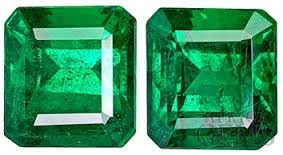According to the theory of Color
Expression, each and every color affects our emotional and mental
experience in a different way. We associate our emotions with colors very
easily, for eg., red is the color which represents powerful emotions like
courage, anger, resentment etc. Likewise every color has a psychological
property. One of the color which instigates a very calming and soothing effect
is the color Green. It represents harmony, refreshment and environmental
awareness.
Nature has worked at its best to provide the mankind with this
refreshing color everywhere, not only in the forms of flaura and fauna but even
in the forms of gem material. One such exquisite example is – Emeralds. Emerald is a gem best known for its vivacious
green color and is one of the most desired gem in the world along with its
other two big competitors ruby and blue sapphire.
This post of The Jewel Affair is aimed at putting together all
important information, facts and other interesting aspects of this gorgeous
gem.
History of
Emeralds
Emeralds have been unearthed for ages and have been encompassed by
many cultures around the world. The name emerald is derived from Greek word Smaragdus, and over the years the name
was altered. It is said that emeralds marked their presence in the history as
early as 330 B.C and were mined in Egypt. Cleopatra, the Egyptian Pharaoh
fancied emeralds.
Another important occurrence of emeralds was marked in the 16th
Century when Spanish invaded South America. Fine emeralds were discovered in
Columbia and till date high quality emeralds are being mined. In fact, Columbian
emeralds set the highest standards because of its extraordinary hues. The term
“Columbian Emerald” is used to define finest quality emerald, irrespective of
its origin.
Emeralds cast their spell not only in Egypt and South America but
also countries like India, Iran and Rome. The treasures of the Mughals in India
were loaded with emeralds and many a times sacred texts from Quran were inscribed
on emerald tablets. The Iranian Crown Jewels have been adorned with Emeralds.
Likewise, there are many such instances which have proved that emeralds have
been fancied from times immemorial around the world.
Formation of
Emeralds
Formation of emeralds is a fascinating process. Mankind is reaping
the fruits of geological activities which have taken place millions of years
ago.
Emerald formation can be divided in two categories:
Metamorphic formation – here emeralds are formed in pegmatites which are igneous in nature and
are a source of beryllium. During the cooling and crystallisation process,
pegmatites come in contact with schists which are metamorphic in nature and a
source of chromium or vanadium which result in formation of emeralds.
Hydrothermal Vein formation – a hydrothermal vein is formed when hot
fluids carrying minerals enter a crack in the rock and the minerals crsytallise
due to precipitation. When hot fluids carrying beryllium come in contact with
sedimentary rocks like limestone which provide chromium emeralds are formed.
Important
factors that help in determining the value of an Emerald:
Gemstones are valued with the help of various aspects such as cut,
color clarity, origin, size etc.
Likewise emeralds also have certain important value factors, which
include color, clarity and cut.
Color is the most significant feature when it comes to emeralds. The
ideal emerald color ranges from a pure green to bluish green, having vivid
saturation and a medium tone. If the blue or yellow overtones overpower, then
the gem will not classify as an emerald, but as a different variety of the
beryl group.
 |
| BLUISH GREEN EMERALD COLOR |
The most famous emerald sources like Columbia, Zambia, Brazil and
Zimbabwe produce gems with color which are typical of the location. For example
Columbian emeralds have a pure intense green color with or without the bluish
overtones whereas, on the other hand Brazilian emeralds have stronger blue
overtones and the color is slightly less saturated. Often the trade uses terms
like “Colombian” , or “Zambian” to describe the color of an emerald
irrespective of its source location.
Clarity is another imperative factor which has a great bearing on the
value of an emerald. Mostly, emeralds display a variety of inclusions which
affect the transparency of the gem. Emeralds commonly have a lot of fractures,
fingerprint inclusions, two or three phase inclusions and mossy inclusions which are termed as jardin. If the inclusions affect the transparency to
a great extent then the value of an emerald drops drastically. Gem trade
usually accepts visible inclusions in fine quality emeralds. Along with this
most of the emeralds available in the market are treated to impove their
appearance. Common treatments are fracture filling, oiling, laser treatment
etc.
 |
| FINGERPRINT INCLUSION |
 |
| FRACTURES |
 |
| JARDIN |
Cut in an emerald depends a lot on its inclusions and depth of the
color. A cutter has to fashion the gem in such a manner which enhances its
value and minimise the weight loss. The most popular cut for emeralds is a kind
of step cut which is called the emerald cut. In this cut the facets are
parallel to each other and beveled corners along with a large table.
When all these factors are in balance the value of an emerald
escalates considerably.
Emeralds are extremely fascinating and so is the study of this gem.
Part-2 of this article will talk in detail about various treatments carried out
on emeralds along with important emerald mines and emerald imitations.





